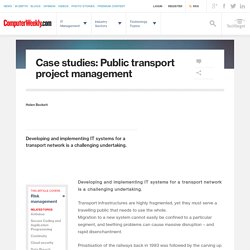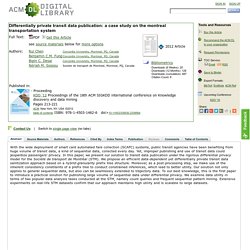

U.S. Gov Census Bureau Geographical Mobility 2005 to 2010. Big Data comes to transport planning: how your mobile phone helps plan that rail line. Understanding peoples’ travel activity patterns, and ideally understanding the motivations and choices underlying them, are at the heart of what transport planners do.

An understanding of trip origins and destinations – and how trip-makers select routes, modes and destinations – are required to plan extensions or changes to a road or public transport network; to assess the viability of a new investment; and to assess how well the existing transport system is serving the population and businesses in a specific area. Indeed, in our roles as transport specialists in the World Bank, much of our job is about supporting clients’ ability to develop this understanding and to use the results to evaluate and appraise investments.
At the core of this process is an Origin-Destination (OD) survey: essentially a matrix of trips between different zones of a region (referred to as an OD matrix). Analyzing Cell Phone Location Data for Urban Travel: Current Methods, Limitations and Opportunities. OECD Mobility Data Changes and Opportunities International Transport Forum.
Case studies: Public transport project management. Developing and implementing IT systems for a transport network is a challenging undertaking.

Transport infrastructures are highly fragmented, yet they must serve a travelling public that needs to use the whole. Migration to a new system cannot easily be confined to a particular segment, and teething problems can cause massive disruption – and rapid disenchantment. Privatisation of the railways back in 1993 was followed by the carving up of the national bus and London Tube networks into franchises. “Getting the various operators together to agree something that the travelling public takes for granted is a major task,” says David Hytch, principal transport consultant at LogicaCMG. “And it is of little value if just one operator innovates, because the fallout of an inconsistent service hits all operators.”Similarly, the all-important return on investment that dictates any commercial investment is constrained in the transport industry by franchise lifecycles.
Case study: Oyster gets moving. Intelligent transportation system. Intelligent transportation systems (ITS) are advanced applications which, without embodying intelligence as such, aim to provide innovative services relating to different modes of transport and traffic management and enable various users to be better informed and make safer, more coordinated, and 'smarter' use of transport networks.

Although ITS may refer to all modes of transport, EU Directive 2010/40/EU (7 July 2010) defines ITS as systems in which information and communication technologies are applied in the field of road transport, including infrastructure, vehicles and users, and in traffic management and mobility management, as well as for interfaces with other modes of transport.[1] Background[edit] Recent governmental activity in the area of ITS – specifically in the United States – is further motivated by an increasing focus on homeland security. In the developing world, the migration from rural to urbanized habitats has progressed differently. Wireless communications[edit] Differentially private transit data publication. With the wide deployment of smart card automated fare collection (SCAFC) systems, public transit agencies have been benefiting from huge volume of transit data, a kind of sequential data, collected every day.

Yet, improper publishing and use of transit data could jeopardize passengers' privacy. In this paper, we present our solution to transit data publication under the rigorous differential privacy model for the Société de transport de Montréal (STM). We propose an efficient data-dependent yet differentially private transit data sanitization approach based on a hybrid-granularity prefix tree structure. Moreover, as a post-processing step, we make use of the inherent consistency constraints of a prefix tree to conduct constrained inferences, which lead to better utility. Our solution not only applies to general sequential data, but also can be seamlessly extended to trajectory data.
Automated Data Collection Systems to Improve Public Transport Performance: London. Future of urban transportation Data.